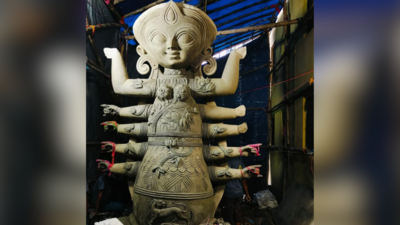ARTICLE AD BOX

Kolkata's Durga Puja celebrations this year commemorate India's freedom struggle and the Partition era
KOLKATA: A Durga Puja in Hatibagan, north Kolkata, is paying tribute to real Durgas from diverse socio-economic, religious, and cultural backgrounds who participated in the Quit India Movement in 1942, a pivotal event that united people across the country. At another Durga Puja at Beleghata Gandhi Maidan in east Kolkata, the focus is on the Partition of Bengal in 1905 and that of India in 1947, shedding light on the lesser-known narratives and the profound impact of these historical events on the Bengali psyche. Simla Byayam Samity in north Kolkata's Singhee Lane, started by freedom fighter Atindranath Basu in 1925, had Netaji Subhas Chandra Bose as President in 1939.
It was stopped by the British from organising the puja there in 1932 and 1934. This year, it will showcase the evolution of the Durga Puja over the last 100 years.The freedom struggle and Partition are recurring themes in multiple Durga Puja pandals across the city in the 120th year of the Partition of Bengal, the 83rd year of the Quit India Movement, and the 78th year of Independence.
Hatibagan Nabinpally is honouring the real Durgas from diverse socio-economic, religious, and cultural backgrounds who participated in the Quit India Movement in 1942, a pivotal event that united people across the country.
Women played a crucial role in the movement, leading protests, engaging in underground activities, and disseminating information after leaders were arrested.Notable figures included Aruna Asaf Ali, who hoisted the Indian flag to initiate the movement; Matangini Hazra, an octogenarian martyred while leading a procession; and Sucheta Kripalani, a steadfast activist who sustained the movement."The theme will be presented in the form of a museum through photographs, sculptures, paintings, and motifs.
While researching the topic, we found references to over 2,500 names. At the pandal museum, we will be showcasing some of them, including Kumadini Dakua, who led the Bhagini Sena (Sister's Army) in East Midnapore, Tileshwari Barua, who spearheaded the Assam Mrityu Bahini, and Usha Mehta, who was India's first radio jockey as she operated a secret radio station through which she inspired countrymen to rise against the British," said theme artist Abhijit Ghatak.While some women were imprisoned, many sacrificed their lives for their country. "These women are the real embodiment of Goddess Durga. Like Maa defeated the evil Mahishashura, these women took up arms to defeat the evil British Empire," the chief organiser of the puja, Dipta Ghosh, said.Belegata Gandhi Maidan Friends Circle Durga Puja Committee has unveiled a pandal that delves into the Partition of Bengal in 1905 and the Partition of India in 1947.
This year's theme aims to shed light on the lesser-known narratives and the profound impact of these historical events on the Bengali psyche.The artist and his research team, who spent months meticulously exploring archives from prestigious institutions like the National Library of India, the Bangiya Sahitya Parishad, and the British Library, unearthed a treasure trove of forgotten stories and perspectives that have been overshadowed by mainstream historical accounts.Visitors to the pandal will be greeted with a striking facade that resembles a giant newspaper, symbolising the "headline" theme. This is a deliberate satire on the countless untold stories that never made it to the front pages. As one steps inside, they are transported back in time through a series of immersive installations that recreate the atmosphere of early 20th-century Bengal.The centrepiece of the pandal is a dramatic representation of the successive headlines from Bengali newspapers of the era.
These headlines, now historical documents, are projected onto large screens, accompanied by audio narrations that bring to life the emotions and turmoil of the time. The installation serves as a poignant reminder of how these events shaped public communication and consciousness in Bengal.In addition to the visual and auditory experience, the pandal also features interactive exhibits where visitors can engage with digital archives and explore personal stories of individuals who lived through the partitions.
This interactive element aims to foster a deeper understanding and connection with the past, particularly for the younger generation.Incidentally, Gandhi was on fast at a maidan in Beliaghata, now known as Gandhi Maidan, to stop riots that were raging in the run-up to the Partition of 1947. "We are striving to present a real picture of the Bengal Partition and the Partition of India, beyond what is written in history books," said the lead artist Asim Pal.
"We want to ensure that these stories are not forgotten and that they continue to resonate with current and future generations.
"Simla Byayam Samiti working President Sohini Roy said that while the Durga Puja celebrating the centenary year has always shunned themes and stuck to the traditional form, it was the first 'theme' puja as the Goddess was adorned in a khadi sari after the call to quit foreign goods during the freedom struggle.The puja started by freedom fighter Atindranath Basu had Netaji as President in 1939. In the 100 years of existence in north Kolkata's Singhee Lane off Vivekananda Road, the puja had to shift to an opposite lane twice in 1932 and 1934 as organising the festival was banned by the British, who branded it a Swadeshi Puja.



.png)
.png)
.png)
















 2 hours ago
4
2 hours ago
4








 English (US) ·
English (US) ·